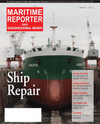
Page 19: of Maritime Reporter Magazine (March 2012)
The Ship Repair Edition
Read this page in Pdf, Flash or Html5 edition of March 2012 Maritime Reporter Magazine
March 2012 www.marinelink.com 19Safety, Fuel Efficiency & Reduced EmissionsKey Benefits of Third-Generation Marine Technology By Iain Weir-Jones, Ph.D, P.Eng. Ferries and ocean going vessels can now sail more efficiently, save fuel, and reduce CO2 emissions by using the Automated Draft Indicator System (ADIS). Weir-Jones En- gineering Ltd. has recently released the third generation of ADIS. ADIS defines the po- sition of the static water plane relative to the vessel. In this way, the position of any part of the ship relative to the water plane can be determined. Based on these measurements, the position and orientation of the vessel including the draft, freeboard, heel and trim are established. The calculations are carried out in real-time and these parameters are con- tinuously updated and displayed. The system is designed to offer: Accurate draft measurements (better than ±10 mm) are displayed, greater precision is available if required. Real-time loading information about hogging, sagging and trim. ADIS digital bridge display can show the draft of the vessel, port and starboard, forward, amidships and aft and cargo tonnes to go. The ADIS installation requires no underwater hull penetrations. Safety: When installed on displacement hulls, ADIS enables operators to: Record precisely how much cargo has been loaded or unloaded . Improve the handling of vessels, or precisely monitor the trim of a floating structure. Keep accurate hard copy loading records to satisfy regulatory requirements. Loading: On cargo vessels and ferries, the system pays for itself by improving fuel ef- ficiency, eliminating disputes about the exact weight of cargo loaded and discharged, and optimizing loading.Fuel Efficiency (trim control): In addition to the benefits of enhanced stability and passenger/ cargo safety, the use of ADIS on ocean going vessels offers two benefits that are becoming important in terms of the environment: improved fuel efficiency and re- duced CO2 emissions. Consider a 300,000 dwt capesize tanker sailing in ballast at about 17 knots. A thirty day voyage, Europe to the Gulf, would consume ~ 2400 tonnes of fuel, ~ 80 tpd, costing ~ $700/tonne, or $1.68 million. Recent studies in Europe and by Mit-sui in Japan indicate that fuel consumption efficiencies of between 5% and 7% can be achieved by optimizing the trim of the vessel. Using the lower figure of 5% produces a fuel saving of approximately $80,000/trip in ballast, with commensurate reduction in CO2 emissions of more than 300 tonnes.PRINCIPLE OF OPERATION The ADIS system is equipped with four ultrasonic transceivers. In standard configu- ration, each transceiver generates short bursts of ultrasonic energy and captures the re- flections from the water surface. The embedded microprocessor in the sensor measures the travelling time of the generated ultrasonic wave and accurately determines the dis- tance of the water surface from the known position of the transceiver. In addition, the sensor uses an internal temperature sensor to compensate for temper- ature effects on the measurements. The sensor digitally sends the distance values which define the position of the water plane relative to the vessel to the central processing unit. In the central processing unit, the position of any part of the ship relative to the water plane is accurately calculated. The draught of the vessel is determined based on the measuring of the port and starboard freeboard, fore and aft. The depth of the keel below the water plane is calculated using the dimensions of the vessel and proprietary algo- rithms, which ensure accuracy by correcting for the presence of propeller wash in dock and waves while underway. Two or more bridge display outputs are available for dou- ble ended vessels or for alternate display locations. The bridge display provides six dig- ital readings; draught forward and aft, draught and freeboard amidships, port and starboard. Data can also be routed to other data storage systems such as the Hull Con-dition Monitoring System and the Voyage Data Monitoring System. About the AuthorDr. Iain Weir-Jones has more than forty years of experience in the design and devel- opment of proprietary monitoring and analytical systems. He can be reached at Email: [email protected] MR March 12 # 3 (17-24):MR Template 3/8/2012 8:44 AM Page 19

 18
18

 20
20
